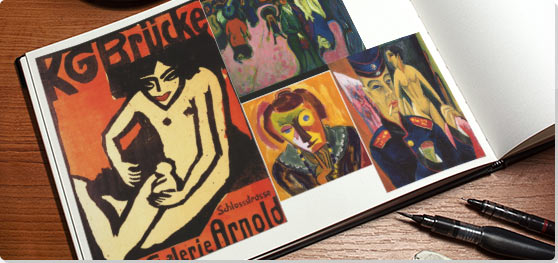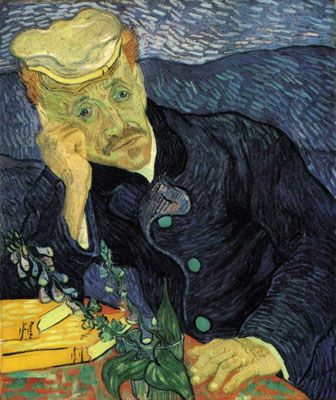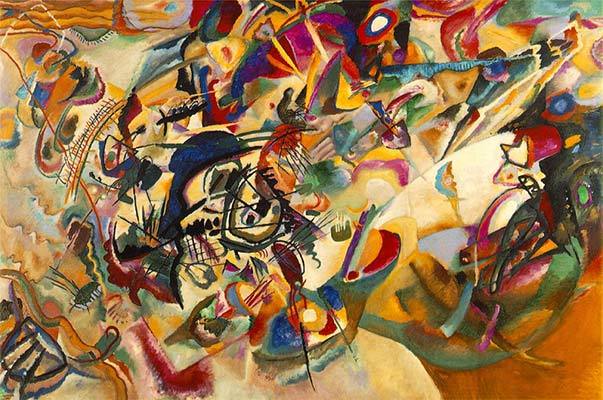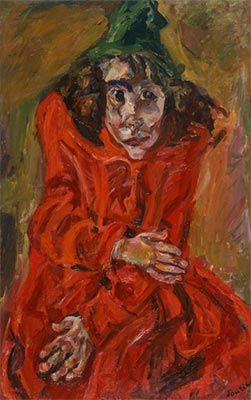Summary of Die Brücke
Progenitors of the movement later known as German Expressionism, Die Brücke formed in Dresden in 1905 as a bohemian collective of artists in staunch opposition to the older, established bourgeois social order of Germany. Their art confronted feelings of alienation from the modern world by reaching back to pre-academic forms of expression including woodcut prints, carved wooden sculptures, and "primitive" modes of painting. This quest for authentic emotion led to an expressive style characterized by heightened color and a direct, simplified approach to form.
Key Ideas & Accomplishments
- Die Brücke is typically seen as the fountainhead of German Expressionism, chronologically the first of two groups (the other being Der Blaue Reiter) that pushed German modern art onto the international avant-garde scene.
- None of the four founding members of Die Brücke, Ernst Ludwig Kirchner, Fritz Bleyl, Erich Heckel, and Karl Schmidt-Rottluff, had received any formal education in the visual arts. They stressed the value of youth and intuition in escaping the intellectual cul-de-sac of academic thought focused on copying earlier models.
- The name Die Brücke was chosen to indicate the group's desire to "bridge" the past and present. From the past, they chose to reassert Germany's rich artistic history, taking inspiration from the print and painting techniques of Albrecht Dürer, Matthias Grünewald, and Lucas Cranach the Elder. Developing the modern example of expressive colorists like Vincent van Gogh, Edvard Munch, and Henri Matisse, sharp and sometimes violently clashing colors are often used in Die Brücke painting to jolt the viewer into the experience of a particular emotion.
- For the artists of Die Brücke, escaping the academy was part of a larger mission to escape the strictures of modern middle-class life. Nudity and explorations of free sexuality in their work (in domestic interiors and in nature) are often contrasted with images of the city, where human interaction is uncomfortably negotiated through prescribed social attitudes.
Overview of Die Brücke
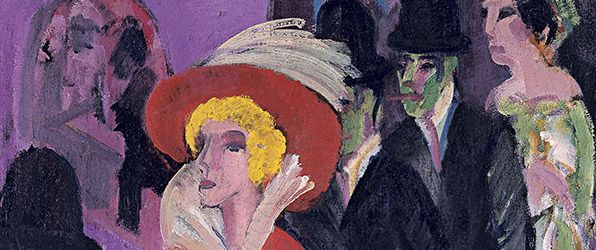
Describing “the years 1911-14 [as] .. one of the loneliest times of my life, during which an agonizing restlessness drove me out onto the streets day and night,” Ernst Ludwig Kirchner painted alienated street scenes. Their expressive angst epitomized Die Brücke.
Artworks and Artists of Die Brücke
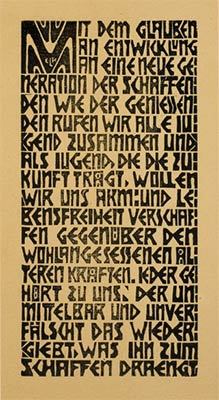
Programme
The charismatic center of Die Brücke, Ernst Ludwig Kirchner composed and printed their original group statement a year after their formation, championing in it their youth and claims of authenticity. The statement, seen here, was turned into a leaflet and distributed at the group's first exhibition. Kirchner's choice of the woodcut medium indicates Die Brücke's reverence for German precedents and direct representation. Moreover, his formal style suggests Johannes Gutenberg's innovations in moveable type, with a large capital "M" serving as the first letter, leading compact lines of printed script. However, a closer look reveals the artistic, handmade nature of Programme, which is evident in Kirchner's irregular lettering. That natural, artisanal approach to art and design was a remnant of his education in the Jugendstil mode of architecture and the applied arts, which would greatly influence early Die Brücke art and philosophy.
Woodcut on paper - The Museum of Modern Art, New York

Poster for the first Die Brücke Exhibition
In September and October of 1906, Die Brücke mounted its first exhibition, focused on the theme of the female nude. The group held the event in the showroom of the Karl-Max Seifert lamp factory, a venue procured through one of Erich Heckel's connections from design school. In contrast to the factory polish of the chandeliers and candelabras on display, Fritz Bleyl designed an expressionistic poster for the event featuring a partially abstracted nude woman. For Die Brücke and its proponents, the figure was striking and direct, reflecting the group's attitude toward open sexuality and the natural state of nudity. Reduced formally by Bleyl's style and the printed medium to a series of curves and contours, the poster was nonetheless deemed too sexually suggestive for public view and banned under the pornography clause in Germany's national penal code.
Color lithograph - Die Brücke Museum, Berlin
Self-Portrait with Monocle
Karl Schmidt-Rottluff's Self-Portrait with Monocle exemplifies the lively, enervating brushstroke common among many Die Brücke painters. Rather than representing himself in a recognizable domestic interior, Schmidt-Rottluff simplified the background in an angular composition of flat panes of vibrant color. He depicted himself in the pose and garb of a bohemian intellectual, complete with brooding visage, green turtleneck, and thoughtful gesture. With the focus placed on his eye and his painting hand, he modernized the pose of Albrecht Dürer, one of the few masters Die Brücke acknowledged, in his well-loved Self-Portrait Wearing a Coat with Fur Collar (1500).
Oil on canvas - Staatliche Museen, Berlin
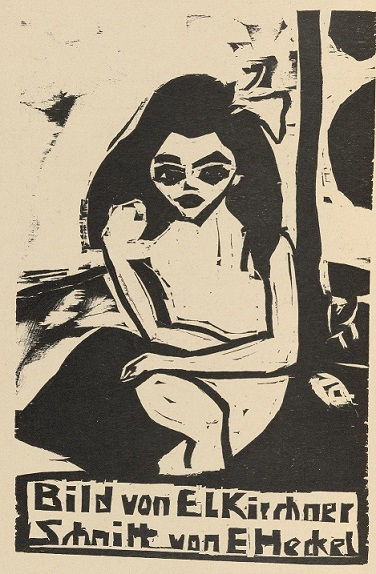
Sitzender Akt (Fränzi) (Seated Nude (Fränzi))
In their studies toward a modern, expressionistic art, the Die Brücke group regularly sketched, painted, and printed images of two young neighborhood girls they used as models, one of whom, "Franzi," (Lina Franziska Fehrmann) Erich Heckel depicts here. The artists' desire for freedom of expression was mirrored in the free movement and relative lack of inhibition of their young muses. In Heckel's woodcut Seated Nude (Fränzi), Franzi's pose and slight grin indicate a lack of shame about her nakedness, while her skinny, immature body provides a visual analog for the artist's angularity and simplification of form. Rendered in stark, unmodulated white, her nudity contrasts with the red and green background tones. Heckel also continued the contour of her nose into the accentuated curves of her eyebrows, a formal convention he culled from non-Western masks he studied in Dresden's Ethnological Museum.
Woodcut - The Museum of Modern Art, New York
Masks
The oldest member of Die Brücke, Emil Nolde, already a seasoned painter, joined the group in 1906. The jarring tonal combinations in Masks show both his maturity as a colorist and his respect for the northern Symbolist heritage of artists like James Ensor and Edvard Munch. These artists often incorporated the mask in their art as the visual language of alienation and disconnect; in Nolde's Masks, the masks melt into and rise from the canvas, creating a grotesque, mocking chorus of faces. His inclusion of the motif was also based on his intense study of African and Pacific masks in the Ethnological Museum in Berlin, where he lived intermittently throughout his adult life. However, his representation of the masks is neither a simple copy nor a transplantation of those forms onto figures in his painting; rather, Nolde enhances the masks with his figural distortions.
Oil on canvas - Nelson-Atkins Museum of Art, Kansas City, Missouri
Under the Trees (Nudes in the Open)
The artists of Die Brücke were often compared to the Fauve painters in Paris due to their bright, vivid canvases and their semi-abstract handling of the human form. And there is certainly common ground between Max Pechstein's Under the Trees (Nudes in the Open) and Henri Matisse's Joy of Life, both of which feature nude figures rendered in vibrant colors in an idyllic landscape. However, while Matisse and his cadre were still borrowing from the Classical tradition, with muses playing flutes, dancing, and making love, Pechstein depicted the landscape and events of actual trips he and his bohemian artist's group took to the country to escape from society and its strictures. Among the radical philosophies Die Brücke espoused was naturism (nudism) as a counterpoint to the industrialization of the modern city. Painted in the year the Die Brücke group moved to the Berlin metropolis, Under the Trees stands as an iconic example of that anti-urban impulse.
Oil on canvas - Detroit Institute of Art
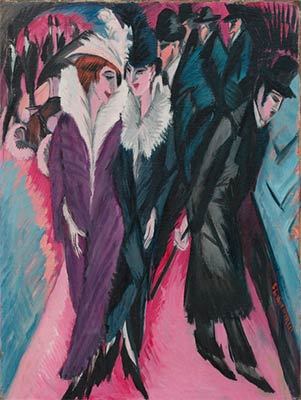
Street, Berlin
Though Max Pechstein moved first, the choice to move the Die Brücke group to Berlin was made largely by Ernst Ludwig Kirchner, who saw greater artistic opportunity in the more populous cultural center. Painted shortly after the breakup of Die Brücke, however, Street, Berlin exemplifies the destabilizing effect the city had on Kirchner, who referred to the years 1911 to 1914 as "the loneliest times of my life." In the forefront are two garishly painted prostitutes who stroll down a street so drastically flattened that they appear to be sliding off the canvas. They are as much on view, for sale, and separate as the trinkets in the storefront window a man peruses on the right. Kirchner would later write that as an artist he identified with the prostitute, being constantly asked to sell himself to survive. Thus, the work can be read as an iconic self-portrait depicting both his formal innovations and the psychological motivations that produced them.
Oil on canvas - The Museum of Modern Art, New York
Beginnings of Die Brücke
Birth of Die Brücke in Dresden, 1905
Ernst Ludwig Kirchner and Fritz Bleyl met in 1901 at the Technical Institute of Dresden as architecture students interested in Germany's Jugendstil tradition, a local variant of Art Nouveau, and became fast friends. Erich Heckel and Karl Schmidt-Rottluff, a few years younger, met in grammar school in 1902 before enrolling in the Technical Institute in 1904 and 1905, respectively. In June 1905, the four students, now friendly colleagues, decided to form an artist's group opposed to tradition and the academic nature of their prior education. The idea of being a collective of artists was central to their thought, and it was established early on that Die Brücke artists would not exhibit outside of the group without permission from the other members. They exhibited aggressively, mounting over 70 shows in their brief eight-year tenure as a collective.
A Bohemian Colony

At the group's genesis, the artists of Die Brücke envisioned themselves primarily as a bohemian collective of artists. This idea was likely influenced by the precedent of Worpswede, an artists' colony in northern Germany established in the 1880s that brought cultural luminaries such as the early Expressionist painter Paula Modersohn-Becker and the writers Thomas Mann and Rainer Maria Rilke into a communal living and working situation.
If Worpswede suggested to Die Brücke that a communal, outdoor lifestyle might be preferable and more natural than city life, Modersohn-Becker's paintings of female nudes (including some self-portraits) in domestic and outdoor settings set the tone for their choice of theme. In Die Brücke's early stages, Kirchner's apartment served as a laissez-faire venue for nude life-drawing sessions and casual lovemaking. This led to what has been referred to as the "vital eroticism" of Die Brücke painting.
New Members, New Personalities
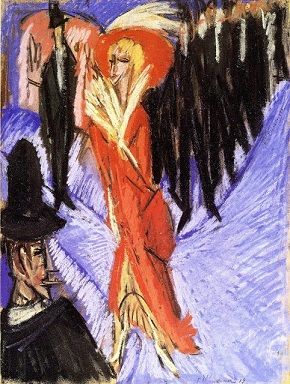
Despite their collective mentality, certain members of Die Brücke held distinct roles in the group. Heckel, for example, became the de facto business manager of the group due to his personable attitude and art world connections. However, Kirchner is typically considered the group's leader, largely due to his attempts to theoretically direct the group, the widely held opinion that his art best exemplified the Die Brücke style, and the fact that he wrote the group's first history, the Chronik der Brücke, in 1913.
Bleyl, who would leave the group in 1907, is often considered as less "important" than Max Pechstein, who joined in 1906. Having met Heckel in 1906 while studying at the Royal Art Academy in Dresden, Pechstein joined the group's lively discussions and came to them as the first member with prior education in painting. Art critics quickly identified him as the "purest" painter of the group, and he was the most financially successful during the group's tenure. Emil Nolde, who was thirteen years older than Kirchner and Bleyl and had been producing work for decades, was invited to join Die Brücke after the artists saw his work at a local exhibition.
The First Die Brücke Exhibition, 1906
In 1906, Heckel obtained permission to host the group's first exhibition at the Karl-Max Seifert lamp factory and showroom in September and October that year. The theme of the exhibition was the female nude, which was advertised by a lithographic poster of a semi-abstract woman created by Bleyl. The exhibition was accompanied by a woodcut leaflet by Kirchner that stated the group's ideals:
"With faith in evolution, in a new generation of creators and connoisseurs, we call together all youth. And as youths, who embody the future, we want to free our lives and limbs from the long-established older powers. Anyone who renders his creative drive directly and genuinely is one of us."
Though the show was not a critical success, the experimentation of the young group was on display for the first time, heralding the rise of Germany's first avant-garde movement. Moreover, the group marketed itself to ensure financial sustainability in the future, seeking both "active members" (artists) and "passive members" (donors).
Developing the Die Brücke Aesthetic
Bleyl broke with the group in 1907 to start a family, and Nolde left shortly after, apparently unwilling to follow the group's rigid exhibition policy. The core of the group was still set, however, with Kirchner, Heckel, Schmidt-Rottluff, and Pechstein working together to establish a radical modern style in German art.
From 1907 to 1911, the group spent a large portion of its time in Dresden, planning exhibitions and using Kirchner's apartment as a hangout and studio. Pechstein moved to Berlin in 1908, but he would often return in the summers, and the artists would pair off and head out of the city to seek the simplicity of nature, particularly near the lakes of Moritzburg. It was during this time that the artists also began frequenting Dresden's Ethnological Museum, developing an interest in Primitivism, which would prove highly influential on their group style.
Inspiring New Expressionisms
After his move to Berlin, Pechstein exhibited with the Berlin Secession, until his and some of his young contemporaries' work was rejected from one of their exhibitions for being too "expressionist," and he helped found the Neue Sezession (New Secession) in 1910. Pechstein succeeded in bringing his Die Brücke cohorts to exhibit with the Neue Sezession in 1910, where they came into contact with and ultimately recruited Otto Mueller.
By 1910, the Expressionist style had developed in Dresden, and Die Brücke had become so popular among young artists that it inspired secession movements in the nation's capital. Indeed, the movement had become known across Germany via its wide-traveling exhibitions. Beyond Berlin, Wassily Kandinsky had formed the Neue Kunstvereinigung Munchen (Munich New Artists' Association) in Munich in 1909, which was something of an incubator for the artistic and theoretical ideas he would promulgate in Der Blaue Reiter (The Blue Rider) group from 1911 to 1914.
The other major movement within German Expressionism, Der Blaue Reiter focused on abstraction in art and claimed that colors held a spiritual value beyond the emotional value attributed to them by Die Brücke. Though they pursued different goals, the two movements tilled common artistic ground and often addressed similar themes, and by the 1910s, works from both groups could be seen in the same exhibitions.
The Move to Berlin
In 1911, Kirchner persuaded the rest of the Dresden painters to move to Berlin, where he had joined Pechstein to found the private art school Moderner Unterricht im Malen Institut (Modern Teaching of Painting Institute) as a way of promoting their new, modern artistic convictions. The group became more involved with the international avant-garde movements of Italian Futurism and French Cubism as a result of the move to the major metropolis, with each artist responding differently to new stimuli. Kirchner, for better or worse, felt enervated in Berlin, and his work took on a more agitated, dynamic quality. Heckel felt alienated by the metropolis, and his color palette became more subdued, while Schmidt-Rottluff embraced its modernity and began to incorporate the fragmented geometry of Cubism and Futurism in his work. The Die Brücke artists would remain in Berlin until their formal breakup in 1913.
Die Brücke: Concepts, Styles, and Trends
In the City, or Of the City?

The artists of Die Brücke derived a great deal of tension in their art from a paradox: though the artists lived in the cities of Dresden and then Berlin, to some extent they never considered themselves of the city. The modern city, as depicted in Die Brücke paintings, is a fantastic realm of attraction and repulsion. To separate themselves from their bourgeois backgrounds, the artists settled into a rebuilt butcher shop in a working-class neighborhood; however, it is unclear how often they roamed those streets for their art, as many of their city images depict wealthy or at least commercial areas.
Nevertheless, the formal qualities of their art were undoubtedly influenced by their experience of urban living. Clashing tones and angular, almost belligerent brushstrokes compose many of their images, even before their contact with the faceting of Cubism and Futurism. While their color choices took on some of the luminosity of the country during their ex-urban travels, their work largely speaks of the experience of modernity through city life.
Nature and Naturism
The artists of Die Brücke did, however, spend quite a lot of time outside of the city, in an attempt to escape the urban landscape. Among Germany's lakes and forests, they were able to live closer to their ideal of a bohemian artists' collective. Their canvases reflected this, turning from urban alienation to themes of happy men and women cavorting naked in nature. Naturism, the philosophy of social nudity, had been defended in German intellectual circles around the turn of the century, and the Die Brücke artists embraced it as part of their radical rejection of bourgeois social norms.
Primitivism and Ethnology
Another concept with which Die Brücke hoped to overturn stale social and academic conventions was Primitivism. Both Dresden and Berlin housed ethnological museums that allowed the group to view African, Pacific, and American artifacts, which they studied for aesthetic inspiration. Though "Primitivism" has negative connotations in the postcolonial era, its use in the arts constituted a genuine attempt on the behalf of modern artists to break through the intellectual constraints of modern Western society by reaching to a "simpler" and potentially "freer" means of expression in less-developed parts of the world. For the artists of Die Brücke (and, for that matter, their contemporaries the Fauves, the Cubists, and the artists of Der Blaue Reiter), this meant their art often evinced a less laborious, more direct rendering of form far from the obsessive pursuit of naturalism and beauty that had previously been considered the highest goal of art.
Printmaking: the Woodcut and the Linocut
Perhaps one of Die Brücke's most original contributions to modern art was the reintroduction of woodblock printing. Germany possessed a storied lineage of printmaking that reached back through the Renaissance-era masters Martin Schongauer and Albrecht Dürer to the stark, angular, and often grainy prints that survived from the Middle Ages. In an attempt to find the most direct form of expression, the artists of Die Brücke regained the techniques of artisan printmakers almost one-thousand years deceased and used them to make powerful statements with strong contrasts. In addition, they modernized this age-old technique by innovating the linocut, which accomplished a similar effect through the use of modern linoleum, which was easier to gouge into than wood.
Later Developments - After Die Brücke
The collective impulse that pushed Die Brücke to its greatest work was ultimately part of the group's undoing. In 1912, Pechstein was expelled from the group for exhibiting work at the Neue Sezession without their consent. The artists' attitudes toward each other began to deteriorate, with some arguments centering around cordial disagreements over artistic and theoretical issues, and some moving beyond to personal conflict. The final straw was Kirchner's authorship of the Chronik der Brücke in 1913, where he emphasized his achievements, claimed that Pechstein had "betrayed" the group by exhibiting with the Neue Sezession, and denied any outside influence from Cubism or Futurism. The other members of the group rejected the draft, and Die Brücke dissolved.
As the largely figurative German Expressionist corollary to Kandinsky and Der Blaue Reiter's semi-abstract group, Die Brücke was extremely influential for twentieth-century modernism. Despite Kirchner's assertion that Die Brücke was a wholly German movement, the internationally followed 1912 Sonderbund exhibition in Cologne was centered around the debt that modern art, including Expressionism, owed to van Gogh, Munch, and other modern artists. This ensured that Die Brücke would be recognized internationally as an important player in the development of the later avant gardes.
The following decades saw a host of artists from across Europe take up the figurative Expressionist style begun by Die Brücke. In Germany, Otto Dix and George Grosz were Expressionists influenced by the group who ultimately developed the next major German art movement Neue Sachlichkeit. In Austria, Egon Schiele and Oskar Kokoschka exemplified an idea of artist-as-outcast in a style that drew on Kirchner's example.
And if the abstract variant of Expressionism cultivated by Der Blaue Reiter was a touchstone for Abstract Expressionism in the United States in the work of artists like Jackson Pollock and Mark Rothko, Die Brücke remained an influence on its semi-figurative painters like Willem de Kooning and Philip Guston, whose post-World War II images revised some of the alienation of late Die Brücke canvases. The same could be said for the art of post-WWII Britain, where Francis Bacon and Lucian Freud created distorted and psychologically penetrating figural paintings, often of individuals.
Neo-Expressionism, a painterly reaction to the popularity of Conceptual art and Minimalism in the 1970s, was an explicit reach back to Die Brücke artists like Nolde and Kirchner, and the style dominated the art world well into the 1980s through the works of artists like Georg Baselitz, Anselm Kiefer, Jean-Michel Basquiat, Julian Schnabel, and David Hockney.
